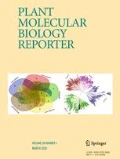Abstract
The presence of certain metabolites has been observed to interfere with DNA isolation procedures and downstream reactions such as DNA restriction, amplification and cloning. The chemotypic heterogeneity among species may not permit optimal DNA yields with a single protocol, and thus, even closely related species may require different isolation protocols. Here we describe the essential steps of a rapid DNA isolation protocol that can be used for diverse medicinal and aromatic plants, which produce essential oils and secondary metabolites such as alkaloids, flavanoids, phenols, gummy polysaccharides, terpenes and quinones. The procedure is applicable to dry as well as fresh plant tissues. This protocol, in our experiments, permitted isolation of DNA from tissues of diverse plant species and produced fairly good yields. The isolated DNA proved amenable to PCR amplification and restriction digestion.
Similar content being viewed by others
Author information
Authors and Affiliations
Rights and permissions
About this article
Cite this article
Khanuja, S.P., Shasany, A.K., Darokar, M. et al. Rapid Isolation of DNA from Dry and Fresh Samples of Plants Producing Large Amounts of Secondary Metabolites and Essential Oils. Plant Molecular Biology Reporter 17, 74 (1999). https://doi.org/10.1023/A:1007528101452
Issue Date:
DOI: https://doi.org/10.1023/A:1007528101452




